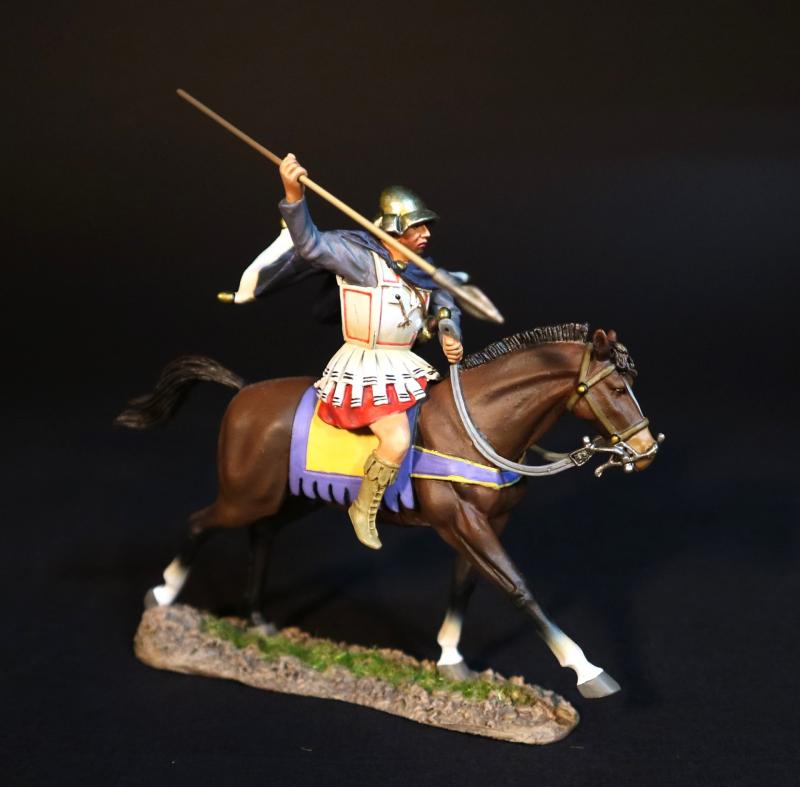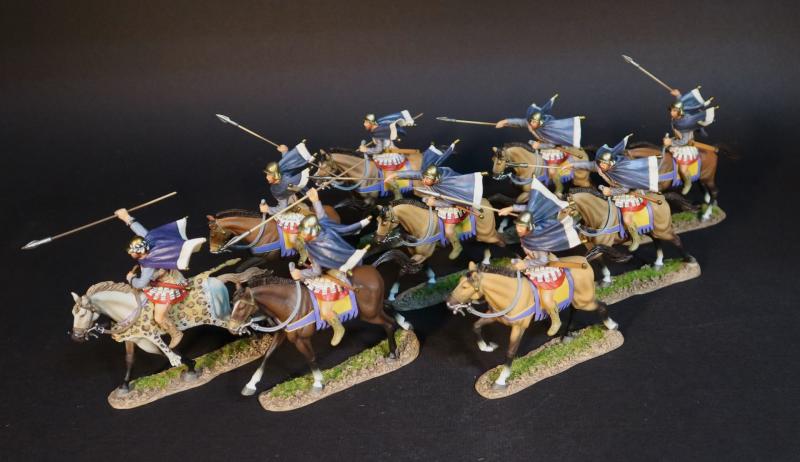Thessalian Cavalry, Armies and Enemies of Ancient Greece and Macedonia--single mounted figure with ready to thrust spear and cloak flapping behind
$108.00
Item Number: MAC-24
Thessalian Cavalry, Armies and Enemies of Ancient Greece and Macedonia--single mounted figure with ready to thrust spear and cloak flapping behind
The main building block of the Macedonian cavalry was the “ile” (squadron) of 200 men, commanded by an “ilarch” and divided into four “tetrarchiai” of 49 men, each under the command of a “tetrarch”. The tactical formation of each Tetrarchia was the wedge, an invention of Philip of Macedonia, with the Tetrarch at the point, and senior troopers riding in the middle and at each end of the base line. It was the aim of Alexander to advance his army obliquely so as to cause dislocations in the enemies line as they attempted to outflank him on his right.
The Persian cavalry column attempting to turn his right flank would be kept at bay by successive charges of his light cavalry, delivered squadron by squadron. As the Persian cavalry was forced to move further to the right, they would eventually lose contact with their main battle line. As soon as this dislocation was observed in the persian battle line, Alexander personally led the decisive charge of his heavy cavalry straight for it. This was not possible until new cavalry formations which allowed the squadrons to redeploy rapidly and reorient the axis of attack. The wedge gave this flexibility to Alexander’s cavalry, which is vividly illustrated in Curtius’ description of the cavalry fighting at Issus which took place when a massive Persian Cavalry column charged the Thessalian cavalry.
“But on the right the Persians were strongly attacking the Thessalian horsemen, and already one squadron had been ridden down by their very onset, when the Thessalians, smartly wheeling their horses about, slipped aside and returning to the fray, with great slaughter, overthrew the barbarians, whom confidence in their victory has scattered and thrown into disorder”
The Thessalian heavy cavalry accompanied Alexander during the first half of his Asian campaign and continued to be employed by the Macedonians as allies until Macedon’s final demise at the hands of the Romans.
THESSALIAN CAVALRY
The Army of the Kingdom of Macedon was among the greatest military forces of the ancient world.
The Thessalians are frequently referred to as the best cavalry units in the Macedonian army. This is thought to be because they were raised from the aristocracy of Thessaly, and were the finest horsemen in the Greek world.
The Vanguard squadron was the Pharsalian ile, which formed Parmenio’s personal bodyguard on the left wing at Gaugamela. It was the Thessalians counterpart to the Royal squadron of the Companions.
The Thessalians were identified by their distinctive national cloak, which was identifiable by the two points hanging down both in front and behind the wearer. These cloak ends used to bellow out behind the galloping horseman and gave the cloak its Greek nickname of “Thessalian Wings.” Otherwise the details of dress are similar to the Companions.
Its organization and weaponry were similar to the Companion cavalry, though the earlier Thessalian way of fighting emphasized the use of javelins. The Thessalian cavalry was famed for its innovative use of rhomboid formations, said to have been developed by the Tagos (head of the Thessalian league) Jason of Pherae. This formation was very efficient for manoeuvering, as it allowed the squadron to change direction at speed while still retaining cohesion.
This tactic was later developed by Philip of Macedonia into the Macedonian Wedge formation.
The numbers given for Alexander’s invasion of the Persian Empire included 1,800 such men. They were typically entrusted with the defensive role of guarding the left flank from enemy cavalry, allowing the decisive attack to be launched on the right. They often faced tremendous opposition when in this role. At Issus and Gaugamela, the Thessalians withstood the attack of Persian cavalry forces, though greatly outnumbered.
Parmenio was a Macedonian general in the service of both Philip II of Macedon, and Alexander the Great. A Thessalian nobleman, Parmenio rose to become Philips chief military lieutenant and Alexander’s military general. He was assassinated after his son Philotas was convicted on a charge of treason.
Although Alexander was recognized as king in Macedonia in October 336 BCE, his accession was opposed by Attalus, a general in Parmenio’s army. In response, Parmenio put the general to death, even though Parmenio was father in law to Attalus. Parmenio recognized that this was a necessary act if Alexander’s succession was to be smooth. As a consequence, Alexander was in Parmenio’s debt.
As a result, a number of Parmenio’s relatives were placed by Alexander in key positions in the Macedonian army. The youngest son, Nikanor became commander of the infantry regiment known as the shield bearers, his son in law Coenus commanded a phalanx battalion while another relative named Nicanor became admiral of the navy. Parmenio’s oldest son Philotas was made commander of the Companion cavalry.
The Thessalian heavy cavalry accompanied Alexander during the first half of his Asian campaign and continued to be employed by the Macedonians as allies until Macedon’s final demise at the hands of the Romans.
Released in APRIL 2024.

